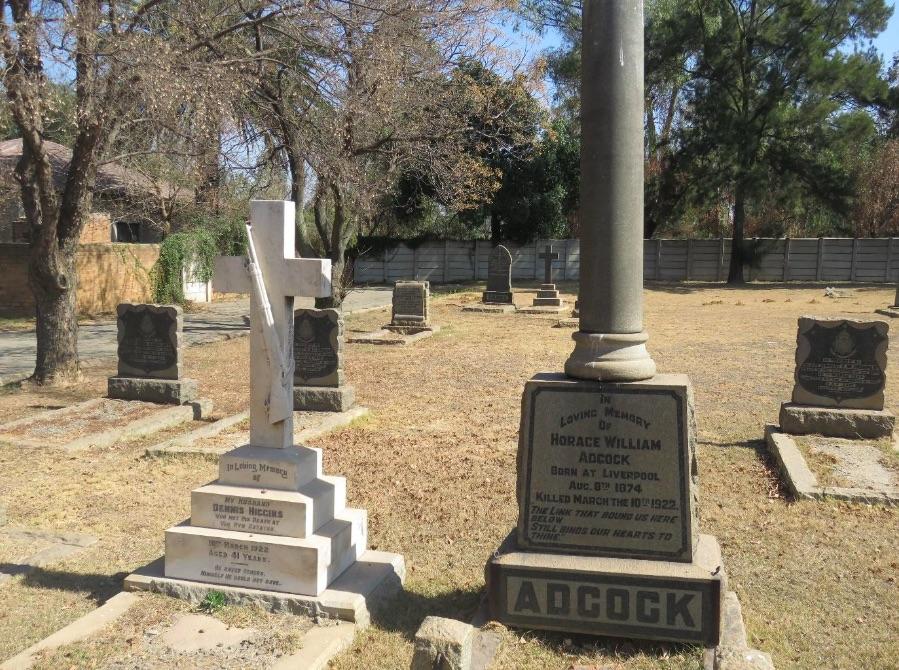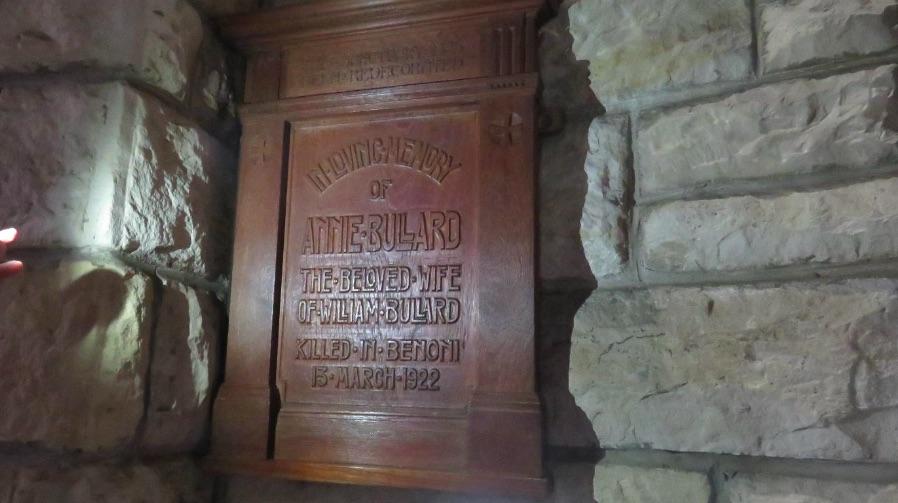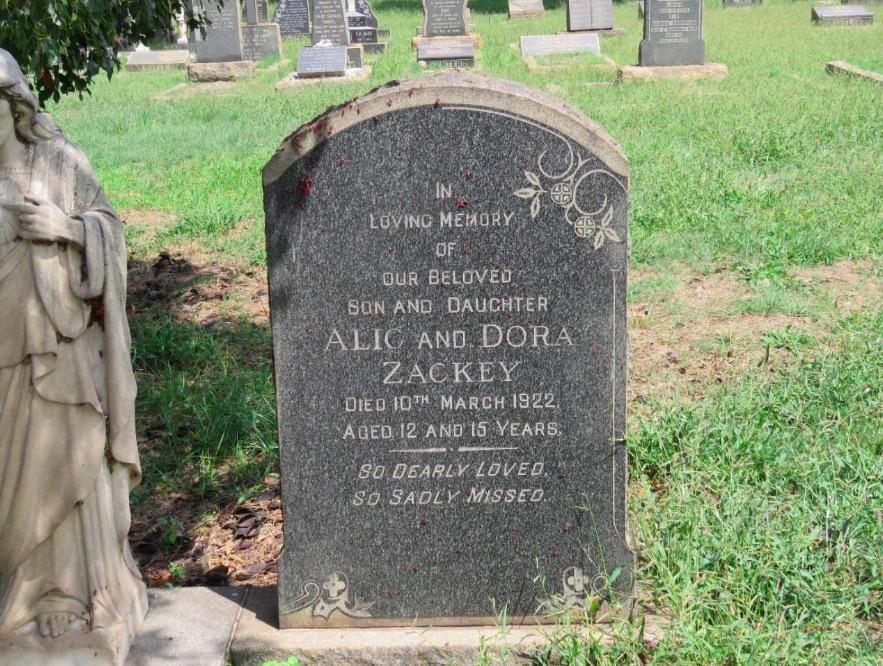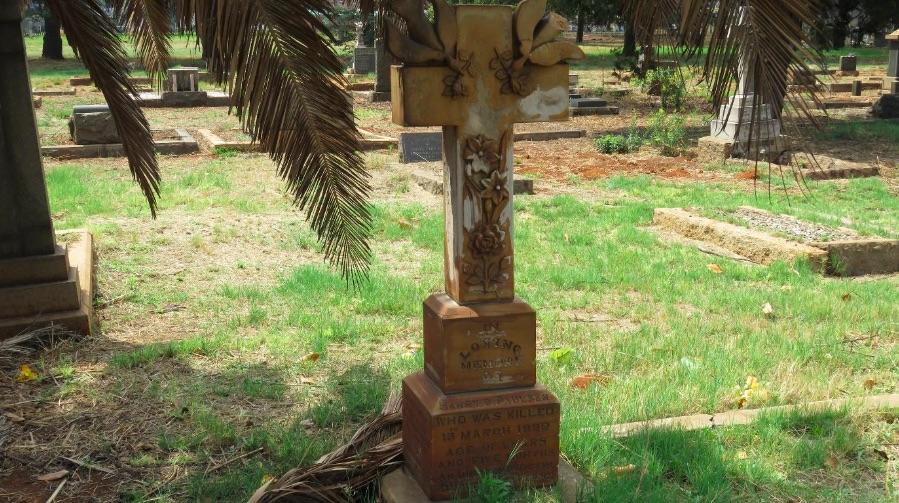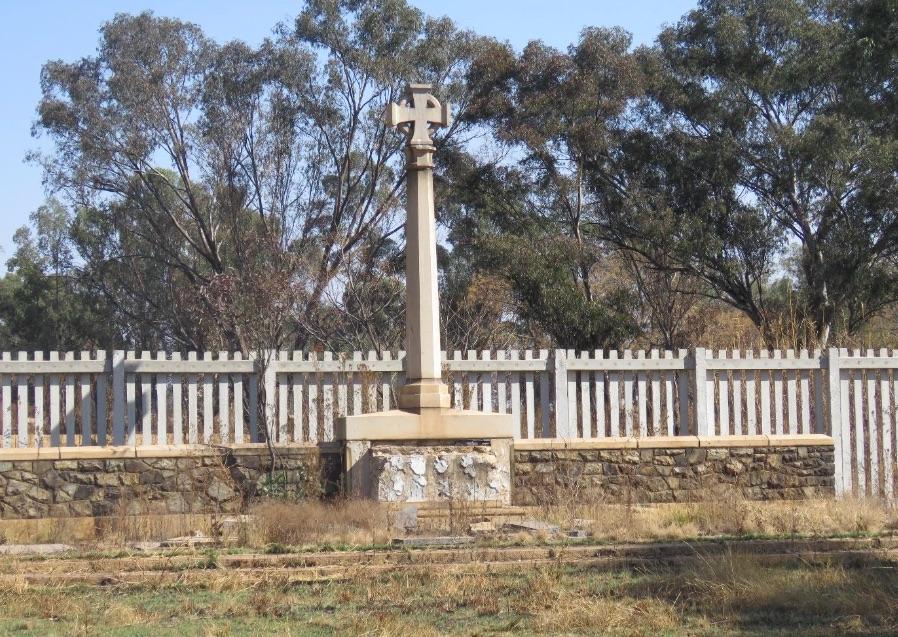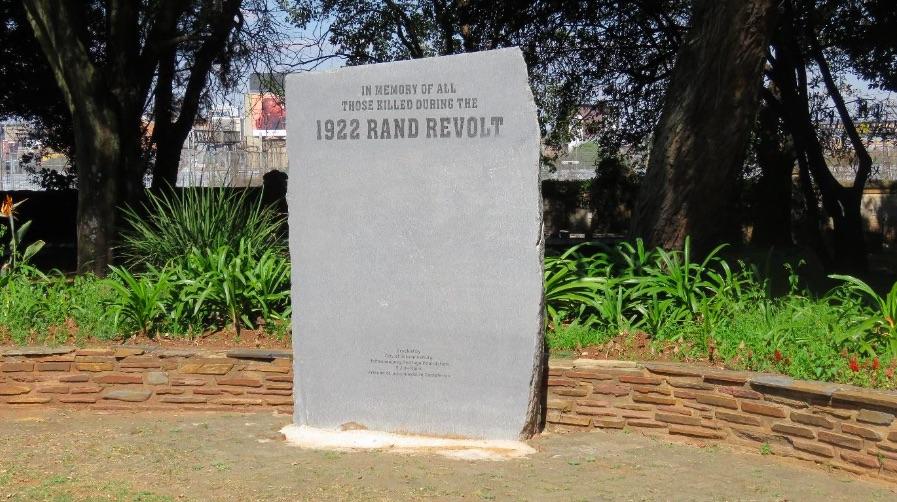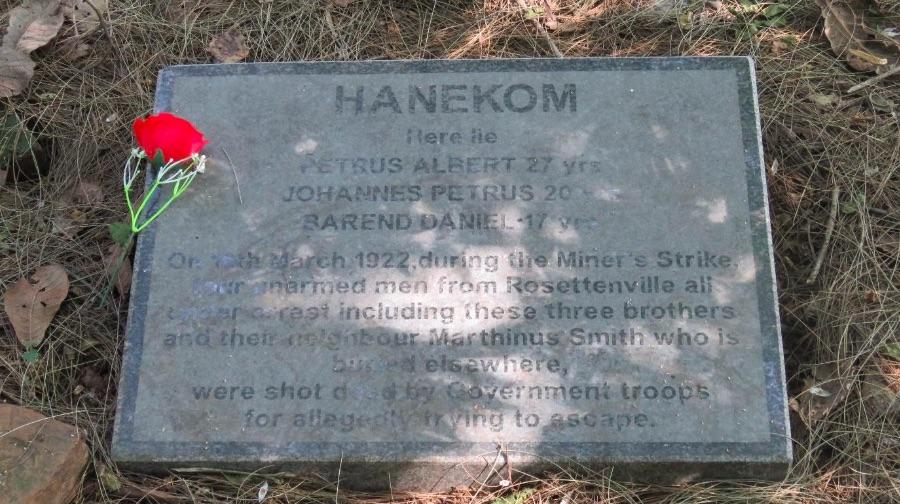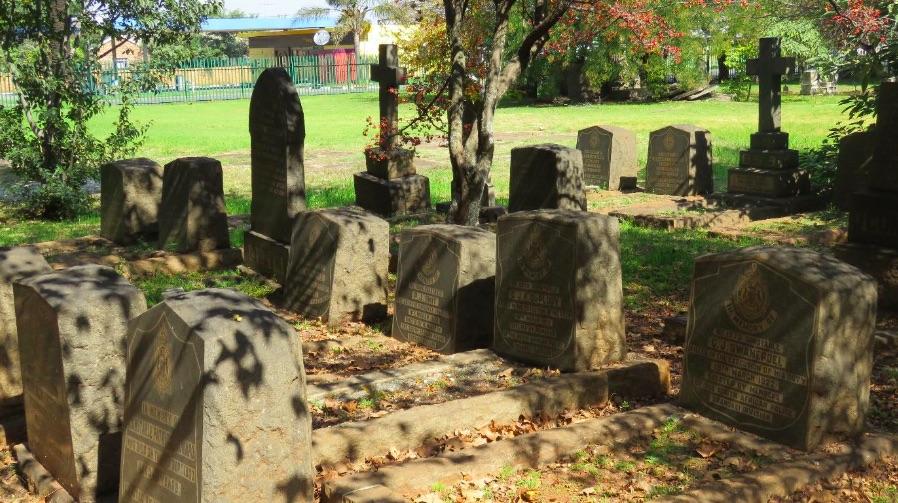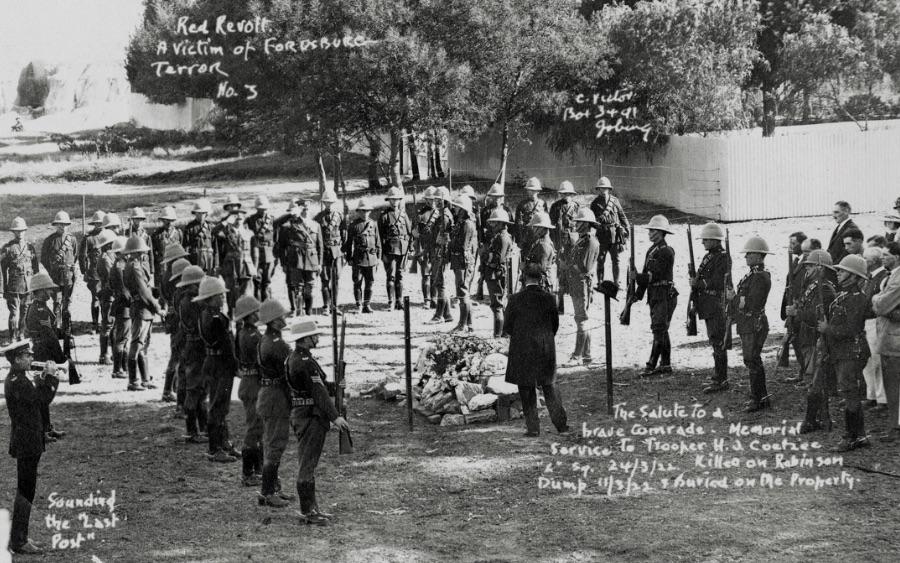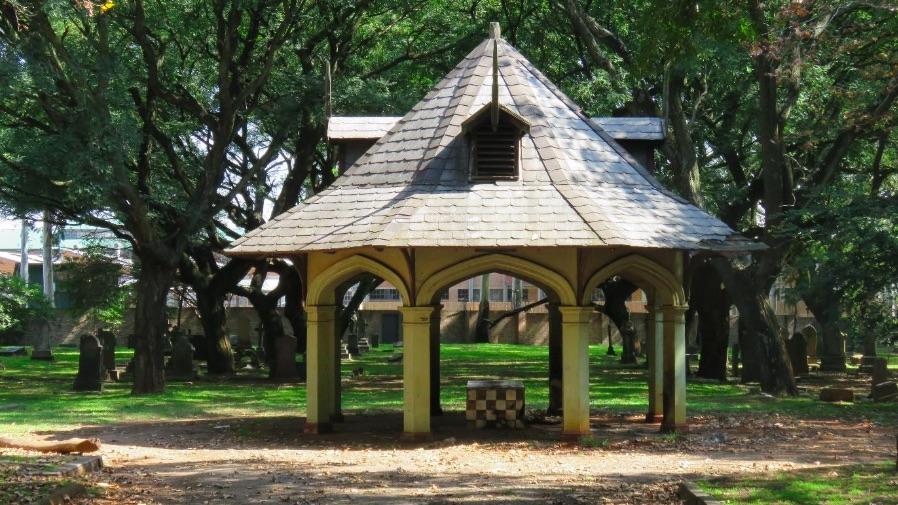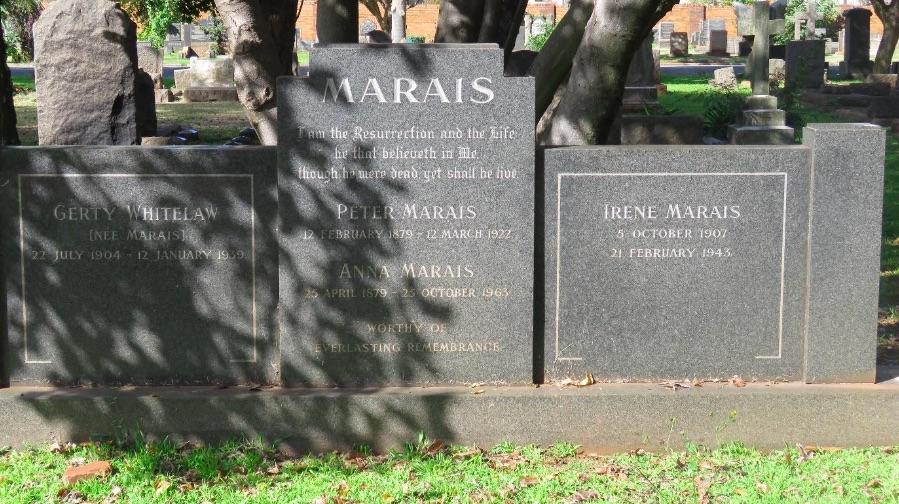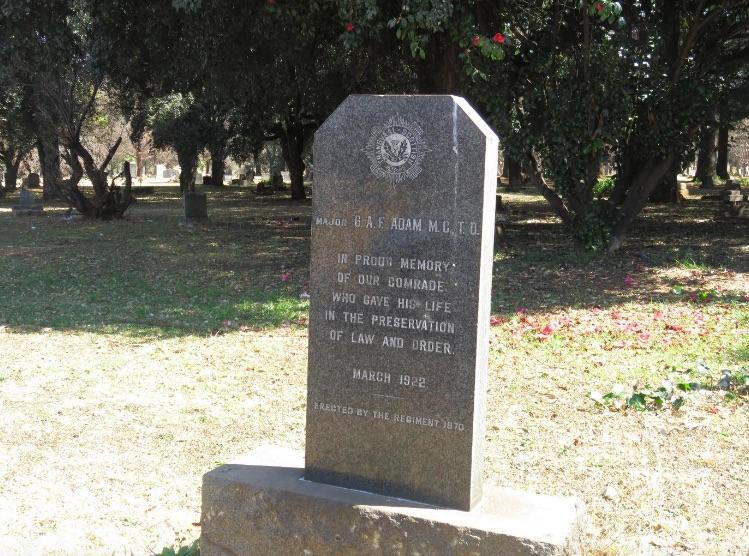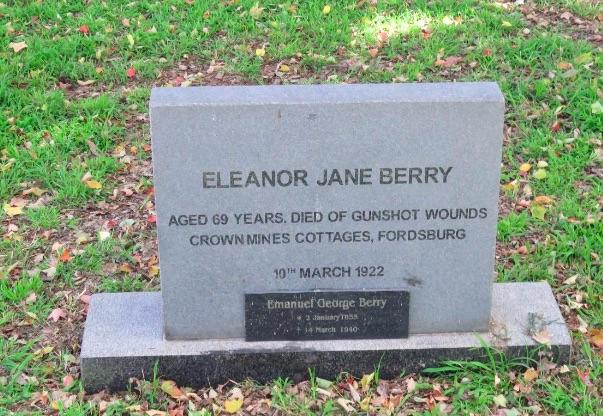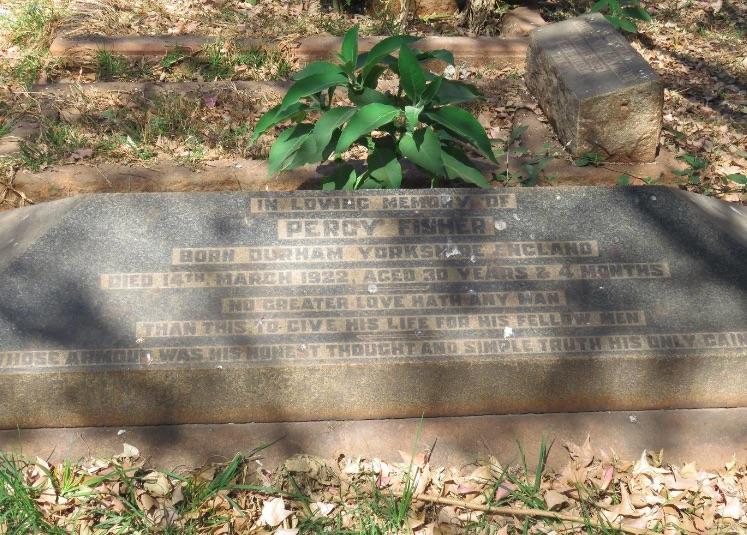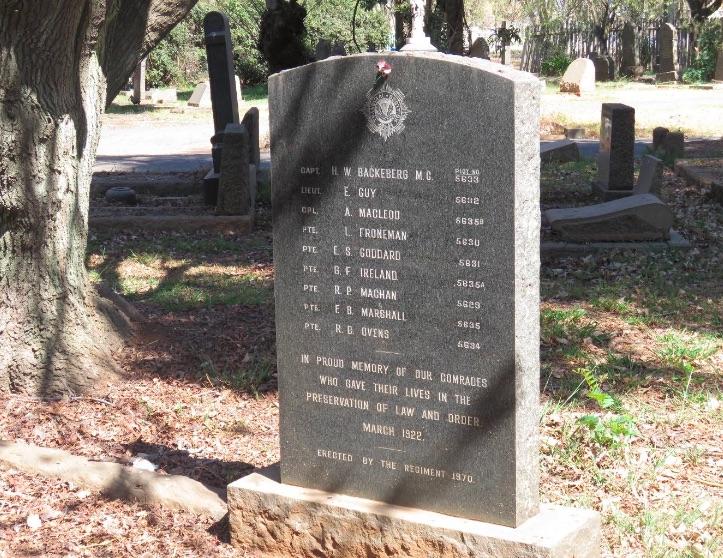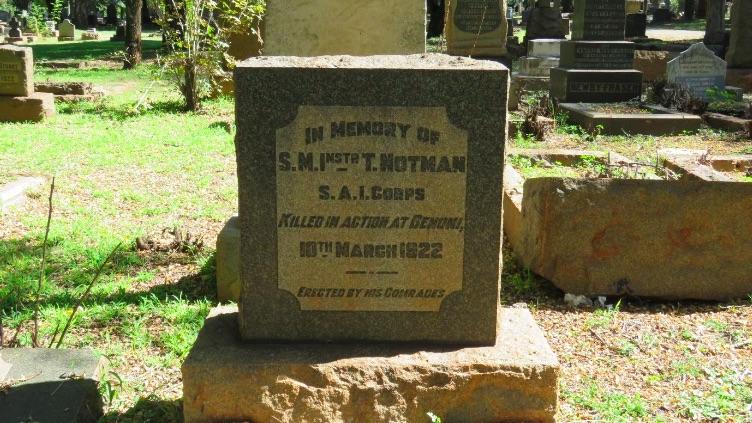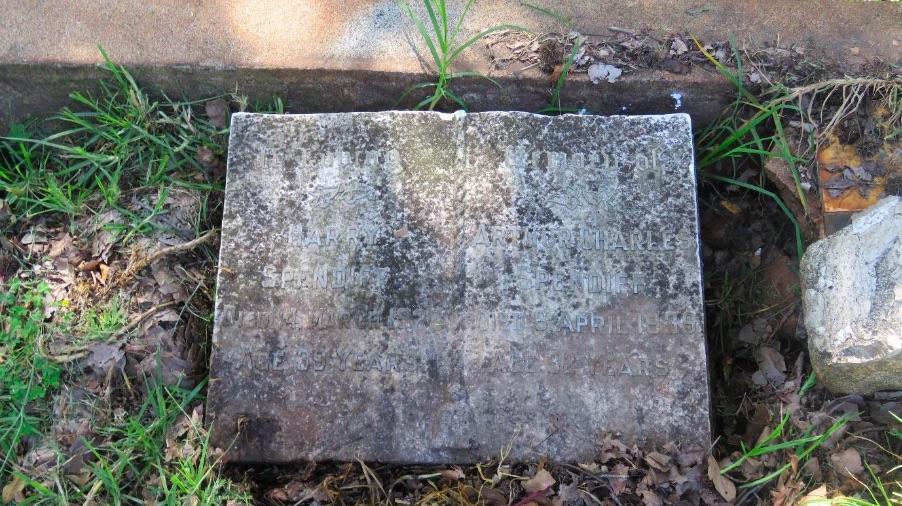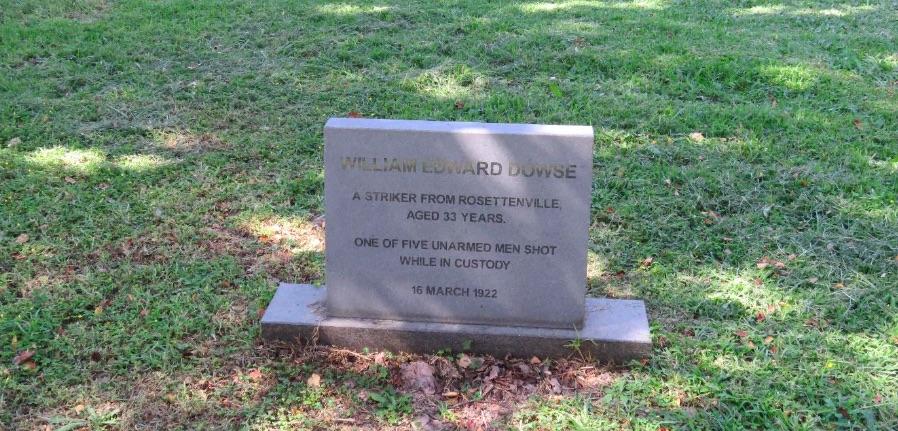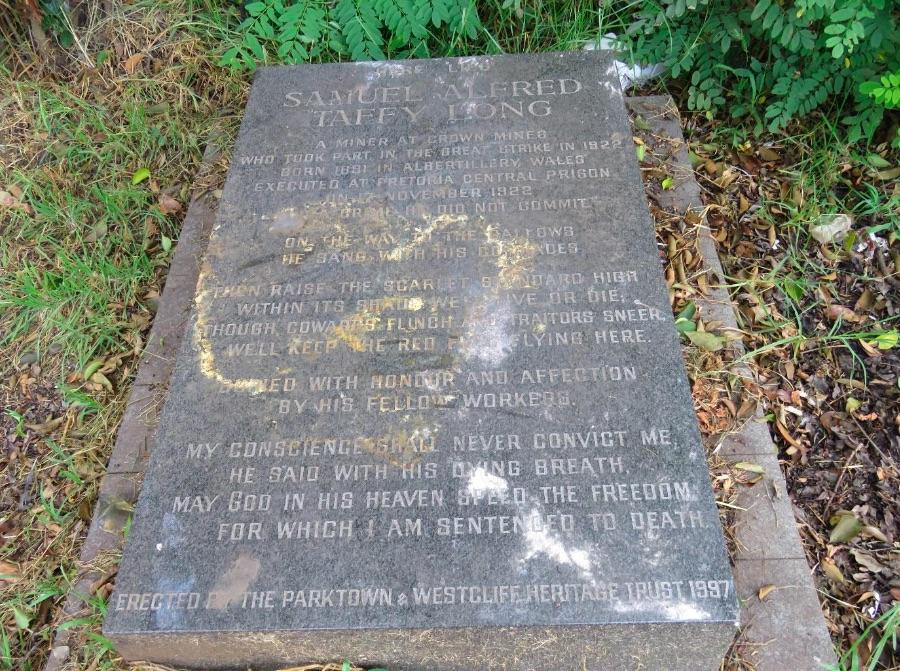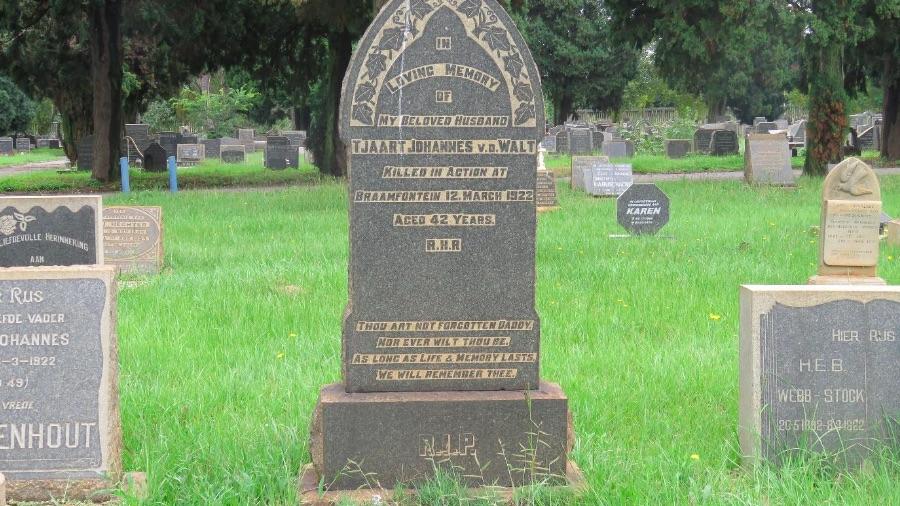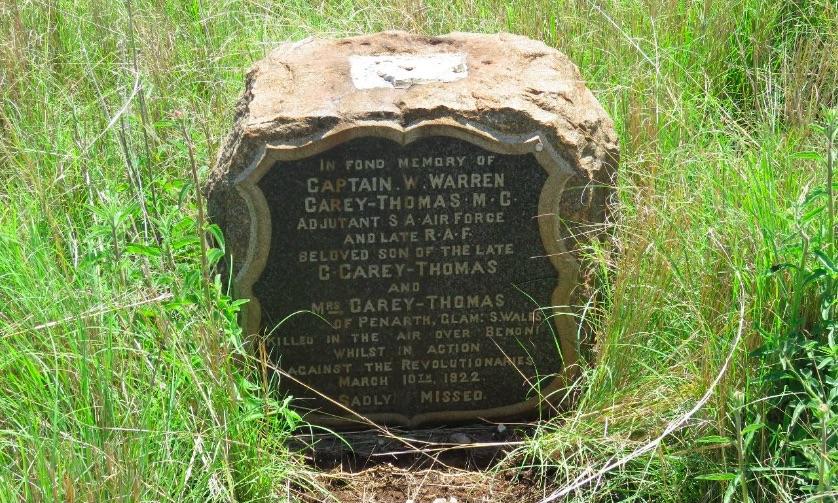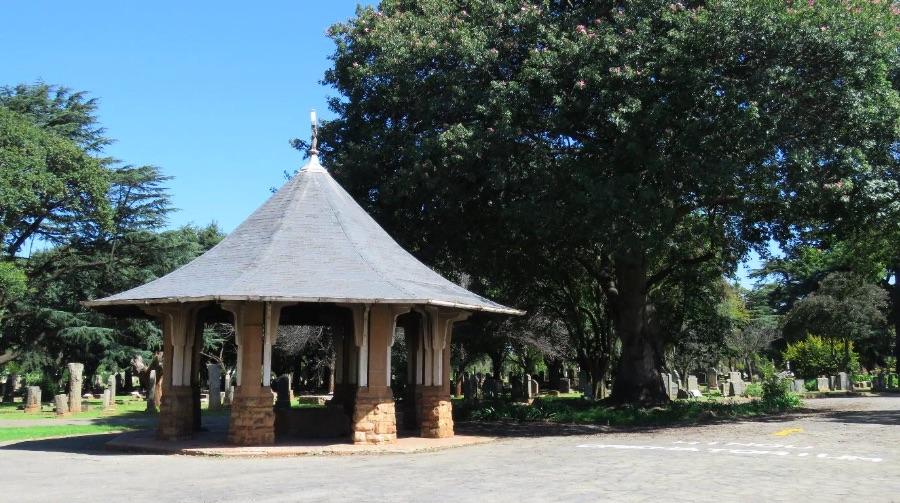
Disclaimer: Any views expressed by individuals and organisations are their own and do not in any way represent the views of The Heritage Portal. If you find any mistakes or historical inaccuracies, please contact the editor.
The first quarter of 2022 marked the centenary of the great White Miners’ Strike on the Rand, also referred to as the Rand Revolt, or even the Red Revolt.
The causes of the Rand Revolt and its suppression by the government are well known. Less well known, is how many people were killed and where their remains now rest.
Conflicting statistics abound and quite possibly we may never know the actual number of people killed during this violent insurrection.
Perhaps the most authoritative account, the Report of the Martial Law Inquiry Judicial Committee concluded the number of fatalities comprised 43 soldiers, 29 policemen, 11 revolutionaries, 28 suspected revolutionaries and 42 civilians (18 European and 24 others), totalling 153.
A Police Plaque, previously mounted in the now virtually demolished Marshall Street Barracks, detailed the rank, initials and surname of 26 White Policemen, 6 Special Policemen and 3 ‘Native’ Policemen, who lost their lives during this great Revolt.
The Story of a Crime being the Vindication of the Transvaal Strike Legal Defence Committee, published and sold for the benefit of the Strike Victims Dependants Relief Fund, mentioned 12 civilians by name; 3 children, 3 women and 6 men, all killed in Benoni.
Fortunately, the regimental histories of the Active Citizen Force (ACF) units on duty during this Revolt recorded the names of their Officers, Non-Commissioned, and Men killed in action or lost through accidents. We were not able to locate the campaign history of all the regiments active during this period, but at least the ones who suffered the greatest loss of life.
By recording the names of fatalities mentioned in various literature on the Revolt, perusing the informative Allatsea and Genealogical Society of SA websites, and scrutinising old burial registers, Sarah Welham, Convenor of the Friends of Johannesburg Cemeteries, and I managed to locate the names, some biographical details, and most of the graves of some 180 of the victims killed.
Scrutinising the Rynsoord Cemetery Burial Register for March 1922 (SJ de Klerk)
The biggest discrepancies in numbers of fatalities relate to strikers and Black people. Our efforts were hampered by the then common practice of not recording the full names and surnames of Black victims in cemetery burial registers.
Furthermore, following the Revolt, many impoverished White striker families would have been unable to afford a tombstone to mark the grave of a beloved, thus many victims may still rest in unmarked graves across the country.
The official history of Benoni, Benoni Son of My Sorrow, claimed the remains of eleven strikers were subsequently disinterred from the Rynsoord Cemetery and buried elsewhere, most likely on distant family farms. We have not yet been able to track down any of these farms, nor the applicable graves.
Lastly, and most frustrating, at one historic cemetery, the cemetery burial registers prior to 1937 have been lost.
At this stage, we can only estimate the total number of deaths due to the violence on the Rand, numbered between 180 and 220.
The social historian may find the language spoken by the deceased makes for interesting reading and interpretation. Approximately 78 (43%) of the 180 deceased, across all categories comprising Military, Police, civilians and strikers, whose names we managed to locate, appeared to be Afrikaans speaking.
Eighteen (53%) of the 34 Police and Special Policemen seemed to be Afrikaans speakers. Thirty-one (61%) of the approximately 51 strikers killed or sentenced to death after the Revolt were also of Afrikaans descent. It confirms that by 1922 most miners and workers in the semi-skilled occupations were of Afrikaans descent. In many instances this Revolt ended up as a ‘broedertwis’, pitting Afrikaans speaking Miners and Strikers against their kith and kin in the South African Police.
With the upsurge of interest in the 1922 Rand Revolt, we trust this document will be useful to those interested in the history of the Rand Revolt or locating the graves of ancestors killed during this violent event.
1) Temporary Cemeteries - Milner Park and Brakpan Dutch Reformed Church
When the violence was at its worst, from ‘Black’ Friday 10 March to 14 March 1922, it became impossible to perform burials at the Braamfontein, Brixton, or Rynsoord Cemetery in Benoni. Consequently, on Sunday 11 March 1922, the authorities set up a temporary cemetery in Milner Park where 33 soldiers and/or policemen together with 29 strikers and/or civilians were buried. We do not know exactly where this temporary cemetery was situated but assume it must have been in the vicinity of the railway line that used to run from the Braamfontein Railway Station beneath Smit Street along the western boundary of the Braamfontein Cemetery, underneath Enoch Sontonga Avenue to the Milner Park Show Grounds, now the Wits West Campus.
The military and police occupying the Milner Park Show Grounds dug trenches near this railway line and most likely some of these trenches would have been used as temporary mass graves, much as the main trench on Spioenkop became a mass grave for British soldiers killed during the battle for this strategic hill in January 1900. On 5 May 1924, the last of these remains were disinterred from Milner Park and reinterred in the Braamfontein, Brixton and other cemeteries.
Brakpan and the 1922 Strike, stated a few strikers were temporarily interred in the grounds of Dominee Oosthuizen’s Dutch Reformed (DR) Church in Victoria Avenue, Brakpan.
2) Benoni - Rynsoord Cemetery
According to our research, the Rynsoord Cemetery contains the remains of at least 30 people killed during the Rand Revolt.
In the old No. 1 Dutch Reformed (DR) Precinct, we located 10 graves of which only one has a tombstone, that of Gert G. van Rooyen at grave no. 375 who died (or most likely killed) on 12 March 1922. He is mentioned in Story of a Crime being the Vindication of the Transvaal Strike Legal Defence Committee (hereinafter referred to as Story of a Crime) as one of the innocent civilians killed in Benoni. His tombstone is surrounded by the other unmarked graves.
Tombstone of Gert van Rooyen in the middle of the photo. The grave of Mrs. Truter killed by a bomb dropped by the SAAF is directly behind Linde’s tombstone on the left. (SJ de Klerk)
The remains of Charlotte Enid Lombard, a housewife killed on 12 March by a gunshot wound to the neck and spine, lie in grave 376. She is mentioned in Story of a Crime.
‘Old’ Mrs. Maria Magdalena Truter is buried in grave no. 377. She has the dubious distinction of being the first civilian in South Africa to be killed by a bomb dropped by the South African Airforce (SAAF). The bomb intended for the Trades Hall was by mistake dropped on the Park Café, c/o Woburn and Bunyan Streets. She is mentioned in Story of a Crime.
The remains of Louis Breytenbach buried on 14 March, lie in grave 378, Abraham Hermanus Bruwer, a miner, killed on 14 March, in grave 379, and Edward Adrian Solomon, a miner killed on 13 March, in grave 380.
Constable Jacob Rudolph Lotter of the South African Police (SAP) killed on 28 March, accidentally shot by a sentry is in grave no. 282. Interestingly, there is no SAP tombstone erected over his grave, although his name appears on the Police Plaque, referred to above.
A short distance away, is grave no. 329 of Dirk Hendrik Ackerman, a miner, killed on 28 February, during a scuffle with the police at the old Boksburg Gaol in Commissioner Street. Apparently, his skull was fractured when a police horse trod on him. Two other strikers were also killed during this disturbance, and their funeral cortege to the Boksburg cemetery extended for two miles. They were the first fatalities, and after this incident the mineworkers’ strike developed into a full-scale armed revolt against the state, seen by the strikers to actively support the mine owners.
Christian Baines de Villiers, a miner, killed on 10 March by a gunshot wound to the heart, lies in grave 427.
The remains of Petrus Jacobus Francois van der Westhuizen, a miner, are in grave 483. He was either killed during the four-day siege of the Brakpan Police Station or during the attack on the Brakpan Mine on 10 March 1922. First buried in the grounds of Dominee Oosthuizen’s Dutch Reformed Church and reinterred in the Rynsoord Cemetery on 27 October 1922.
In the Church of England and Methodist No. 1 Precinct, are the graves of 11 victims.
Four are Police Constables; Benjamin Hannant, Nicolaas Andries Cornelis Kruger, Addison Ridley Jordan, and Frederick Henry Ludwig Howe, killed on 10 March, possibly when ambushed by strikers in Swan Street Benoni. They are interred in graves 244, 245, 249 and 299, respectively and all have tombstones.
The remains of Lance Sergeant Frederick Hooper from the Port Elizabeth unit are interred in grave no. 249. Killed on 12 March, when a force under Colonel Hume entered Benoni with a small force of SA Mounted Rifles (SAMR) after an engagement in which the SAMR and the Police suffered considerable casualties.
Gunner Matthys Johannes Lourens of the SAMR, killed on 13 March, is buried in the adjacent unmarked grave no. 250.
The tombstone of Dennis Higgins is unusual with a rifle mounted on the cross. A Shift Boss at the Van Ryn Estate Gold Mine, he served as a Special Constable during the Revolt and was shot and killed at his home by a mounted striker commando on 10 March 1922. Grave 296.
Horace William Adcock lies in the adjacent grave no. 297. A Mine Detective at the New Kleinfontein Mine, he was shot and killed on 10 March, when strikers fired more than a dozen rounds at the car of the manager of the New Kleinfontein Mine. Not only was Adcock killed but three other men also in the car, including the mine manager, were wounded.
Tombstones of Dennis Higgins and Horace Adcock. Note the police tombstones in the row behind. (SJ de Klerk)
Rather confusingly, the initial cemetery record noted an unknown European male was buried in grave no. 300, later identified as Johannes Hendrik Jooste, a miner, killed on 13 March by a gunshot wound to chest. A torn page in the cemetery’s burial record with half of the surname missing seemed to indicate Trooper George Brown of the Transvaal Scottish killed at Dunswart Railway Crossing on 10 March, was originally interred in this plot. If so, Brown’s remains were later disinterred and reinterred in the Primrose Cemetery. Jooste is mentioned in Story of a Crime. There is no tombstone.
A tombstone was erected in 1970 by the Transvaal Scottish Regiment on the grave of Sergeant Henry Hough Roux, killed on 12 March, during the attack on the Brixton Ridge. Grave no. 447.
Plaque to the memory of Annie Bullard in the crypt of St Dunstan’s Cathedral, Benoni (SJ de Klerk)
Unusually, Annie Bullard née Doubtfire, buried in grave 449, has a tombstone as well as a plaque erected to her memory in the crypt of St Dunstan’s Cathedral, Benoni. She is mentioned in Story of a Crime.
In the Wesleyan Precinct are the graves of 3 civilians, of which two have tombstones. Cyrus St J. Watt, a 16-year-old mechanic is buried in grave 104 and has a tombstone. He is mentioned in Story of a Crime.
Alfred Pengelly, a miner, killed by a gunshot wound through the heart on 10 March 1922, is buried in grave 330, which has a tombstone. He is mentioned in Story of a Crime.
Sidney Beal, a fitter at one of the gold mines was killed on 13 March and buried in plot 151, with no tombstone. He is however commemorated on the tombstone of his parents in the Wesleyan Precinct of the Primrose Cemetery. He is mentioned in Story of a Crime.
Tombstone of Alic and Dora Zackey in the Roman Catholic precinct (SJ de Klerk)
A rather sad tombstone in the Roman Catholic No.1 Precinct, commemorates siblings Alice and Dora Zackey, aged 12 and 15 years respectively, killed by a ricocheting bullet on 10 March 1922. Grave 56. They are both mentioned in Story of a Crime.
In the Presbyterian Precinct are the remains of James James, a butcher killed on 10 March by a gunshot to the heart. Grave no. 152. No tombstone.
There are at least three graves in this cemetery we were unable to locate. One is of a female, LI Swartz, mentioned in Story of a Crime.
The other is that of Louis Johannes Fourie, a miner, killed either during the four-day siege of the Brakpan Police Station or the attack on the Brakpan Mine. Initially interred in the grounds of Dominee Oosthuizen’s DR Church and later reinterred at Rynsoord Cemetery.
The last missing grave is of Johann Godfrey Horak, a miner, also killed either during the four-day siege of the Brakpan Police Station or the attack on the Brakpan Mine. Initially interred at Dominee Oosthuizen’s DR Church and later reinterred here. Derek Walker seems to think he might have been interred somewhere in Pretoria.
3) Boksburg Cemetery
We believe this historic cemetery contains the graves of at least 6 fatalities, although we have been successful in locating merely two graves, and only because they had tombstones.
Tombstone of Harry Ambrose Paulse, a barber, killed on 13 March 1922 (SJ de Klerk)
In the old Church of England Precinct, is the grave of Harry Ambrose Paulsen, a barber, killed on 13 March 1922, aged 21 years. His epitaph reads, ‘Who was killed on 13 March 1922, an innocent victim during the Rand Revolt’.
The other grave containing a tombstone is that of John Henry Erlank, a miner, killed by gunshot to the skull on 12 March 1922.
We suspect that David Krause, a striker, killed at the old Boksburg Gaol is buried in the old DR Precinct. There is an open space where he might have been buried, but no tombstone to confirm this.
We think SAP Constable DJ van Heerden of the Umtata, Transkei Division, shot and killed on the Brixton Ridge on 10 March, might also be buried here. His name appears on the Police Plaque.
Another grave we have been unable to locate is that of Sergeant Arthur James Haviside of the 1st Battalion SAMR, killed in action on 12 March, at the Dunswart Railway Crossing.
The next missing one in this cemetery is a good example of the difficulties we experienced in locating the graves of African victims. Abselom or Abselon, no surname provided, apparently died from concussion on the brain on 16 March 1922.
Unfortunately, as all burial records prior to 1937 at this cemetery have been lost, it seems unlikely that we’ll be able to locate any of these missing graves.
4) Brakpan Mine Garden of Remembrance (ANZAC)
Eight men, either members of the Police/Special Police or Mine Officials were killed by strikers when they attacked the nearby Brakpan Mine Offices on 12 March 1922. Under command of Lieutenant VF Brodigan of the SAP, about 25 Officials and Special Policemen attempted to defend the mine offices against several hundred strikers, while expecting support from the nearby Brakpan Police Station.
Brakpan Mine Garden of Remembrance (SJ de Klerk)
Unbeknownst to them the Police Station was also besieged by strikers, and therefore the Police could not render any assistance to the mine. After stubborn resistance, the defenders surrendered when their ammunition ran out. The enraged strikers who must have lost several men, then proceeded to club or shoot eight of the defenders to death.
Buried here is Lieutenant Brodigan of the SAP, and brother of the Mine Manager. His name appears on the Police Plaque.
Other burials here were those of Special Police Constables, Stephanus Combrinck, TH Jordaan (whose name appears on the Police Plaque) and Frans Hendrik Smit(h) as well as four Mine Officials, GW Lowden (Mine Surveyor), Herbert Martin (Acting Shift Boss), Adrian B Momsen, and Lewis Phillips (Mine Clerk).
This Garden of Remembrance is now very vandalised. The plaque on the monument has been removed, hopefully for safekeeping, read, ‘Victims of Violent Internercine (sic) Strife. They Valued Duty Higher Than Life.’
This monument was designed by architect Allen Wilson, who, amongst others, also drew up the plans for the Tin Temple of 1903, the precursor of Wits University, and the original Hindu Crematorium at the Brixton Cemetery in 1918.
5) Braamfontein Cemetery
The Braamfontein Cemetery, Johannesburg’s oldest extant one, contains many historical and interesting graves. We think as many as 43 victims of the Revolt were interred here.
Braamfontein Cemetery 1922 Rand Revolt Memorial (SJ de Klerk)
A large granite slab with the words, ‘In Memory of All Those Killed during the Rand Revolt’, sponsored by the Johannesburg Heritage Foundation (JHF), the City of Johannesburg, Friends of the Johannesburg Cemeteries, and the writer, was recently placed in front of the crematorium. At present it is the only monument commemorating all those killed during this Revolt.
Perhaps this is a good moment to reflect why there are no monuments to the Rand Revolt. Possibly it is because the Rand Revolt was such a divisive incident in our history. It caused the National Party under General Hertzog and the Labour Party under Colonel Creswell, to enter in an election pact to fight and defeat the South African Party at the 1924 general election. The new Pact Government probably wished to avoid stirring up the recent bitter past and hence the monument at the Brakpan Mine was the only one ever erected, probably on the initiative of the Brakpan Mine Manager Charles Brodigan, whose brother was killed during the striker attack on the mine.
In the Church of England Precinct, next to the crematorium are the graves of two members of the Imperial Light Horse (ILH) Regiment, Lieutenant Walter Harden Heely (grave 23033) and Corporal William Andrew Kirsten (grave 23027). Both were shot and killed on Saturday 11 March at Ellis Park.
Recruits for the ILH were sent to Regimental Headquarters at an old football field in Ellis Park. There they were hastily equipped, formed into dismounted squadrons, and dispatched for duty piecemeal. The regimental history, the Light Horse Cavalcade 1899 – 1961 admitted the choice of Ellis Park was a disastrous error of judgement, for the ground was sited in a basin surrounded by high ground and encircled by houses, and sheds. At 13h30 on Saturday 11 March, members of the Denver and Jeppe Striker Commandos having crept unseen to the edge of the basin, unexpectedly opened fire on about 150 men of the ILH mustering in the centre of the field. Taken by utter surprise the ILH lost 20 men killed and wounded before counterattacking and driving the strikers back.
The regimental history noted between 6 and 7 men were killed, although we have only been able to locate the graves of six members of the ILH.
The graves of two fatalities, one civilian and one striker, John Sutcliffe an engineer, and John (Jack) Davidson, a striker, are now covered by the pathways to the memorial walls at the crematorium and no longer visible. Sutcliffe died on 11 March in the Kensington Sanatorium from a bullet wound to the abdomen, grave 23028. Davidson died of gunshot wounds to the arm and abdomen on 11 March. The Johannesburg Heritage Foundation (JHF) placed a grave marker over his grave, during the recent centennial of the 1922 Rand Revolt. Grave 23030.
Henry Herbert Carr, born in New South Wales and a gardener, who died from a gunshot wound during the Revolt is buried in grave no. 23032 and has a tombstone.
The Johannesburg Heritage Foundation placed an interesting little plaque in the Paupers’ Section, adjacent to the crematorium ash gardens. It commemorates the shooting of the three Hanekom brothers by the Transvaal Scottish Regiment on 16 March 1922.
Grave of the three Hanekom Brothers (SJ de Klerk)
The Hanekom brothers, together with their neighbour Martinus Wessels Smith were apprehended by the Transvaal Scottish for allegedly cutting telephone wires, which they admitted to but said was under duress, and for hiding arms in a secluded valley below Fouche’s Dairy, south of Kenilworth, which they denied. Taken to this secluded valley to point out where the firearms were hidden, they were shot allegedly while trying to escape. Mrs. Smith asked Mrs Hanekom to accompany her to the mortuary as she (Mrs. Smith) feared her husband might have been killed. Upon entering the mortuary Mrs. Hanekom to her shock and horror discovered the bodies of her three sons, Pieter aged 27, Johnny aged 20 and the youngest Bennie aged 17. All three buried in communal grave no. 23035.
The remains of William Henry Reilly, miner, killed by bomb wounds on 12 March, are in the Roman Catholic Precinct. Initially interred in Milner Park, his remains were later reinterred here. The JHF placed a grave marker over his grave during the recent centennial of the 1922 Rand Revolt. Grave 21556.
Further to the west and south of the Dynamite Memorial is the South African Police (SAP) Precinct, containing amongst others, the graves of 10 members of the South African Police killed during the Revolt.
South African Police Precinct, Braamfontein Cemetery (SJ de Klerk)
One can verify the desperate attempts of the South African Police to contain this Revolt by reading on their tombstones from what distant regions across South Africa these Policemen were called upon to assist.
Sergeant George McInroy, husband of Amelia McInroy neé McLennan, killed in action on 11 March lies in grave 23027.
Constable Jeremiah Fogarty killed on 10 March, originally from County Kerry, Ireland, and husband of Julia Fogarty, neé Courtney, lies in grave 23029.
Constable Peter Francis Poplemberg Vickers, SAP Grahamstown Unit, killed in action on 10 March, lies in grave 23047.
Constable George Richard Tee, SAP Durban Unit, killed in action on 10 March, is in grave no. 23048.
Constable Daniel Ronquest Steyn, SAP Aliwal North Unit, killed in action on 10 March, lies in grave 23049.
Constable Stephanus Gerhardus Wehmeyer, SAP Kimberley Unit, killed in action 11 March, rests in grave no. 23050.
Constable Pieter Jacobus Smit, SAP Umtata Unit. Killed in action on 11 March, and initially interred in Milner Park. Husband of Susanna Maria Smit of Willowvale, Transkei. Grave no. 23051.
Constable Cornelis Johannes Frederik du Plooy, SAP Transkei Division, killed in action 10 March. Grave no. 23052.
Constable Cornelis Jacob Swanepoel, SAP Umtata Unit, killed in action 13 March, aged 42 years. Initially buried in Milner Park and now rests in grave 23053.
Constable Hendrik Jacobus Coetzee, SAP Natal Division, killed in action 11 March 1922 on the Robinson Mine Dump, he was initially interred on the mine property. His remains are now in grave no. 23194.
Burial of Trooper (Constable) HJ Coetzee on the Robinson Mine property (Museum Africa)
The names of all ten Policemen appeared on the previously mentioned Police Plaque. The inscription on the Plaque read: ‘To the memory of those officers, non-commissioned and men of the South African Police and Special Police who lost their lives in the execution of their duty during the Witwatersrand disturbances, March 1922. Erected from the Funds generously subscribed by the citizens of the Witwatersrand area and elsewhere.’
In the DR Precinct is the unmarked grave no. 22017 of Special Constable William James Corrigan, accidently shot by a sentry on 17 March 1922. His name appears on the Police Plaque.
Historic Braamfontein Coffin Rest towards the western boundary of the cemetery (SJ de Klerk)
Another interesting but rather sad tombstone is to be found at Grave no. 21248 in the General Precinct, just beyond the coffin rest at the western boundary. It is that of William Ross, on whose tombstone are engraved the names of his three sons. Two of whom were killed in Flanders during the First World War, and his youngest son, Private Frederick Vassey Adams Ross, of the Transvaal Scottish during the Rand Revolt. Aged 23 years he died on 14 March 1922 from wounds received at the Dunswart Railway Crossing on 10 March, where a contingent of his regiment was ambushed by strikers as they detrained and skirmished their way along the railway line towards Benoni. The Regiment lost 6 officers and 6 men on that fateful day.
We were delighted when Alan Buff, previously Parks Manager with the City of Johannesburg, located the graves of several strikers and/or civilians buried in the General Precinct in unmarked graves. Most, if not all of them, were initially interred in Milner Park and later disinterred for reburial in Braamfontein. They are: Pietro Letiza, miner, killed 10 March, reinterred in grave NC 23218; Richard McMurray, miner, killed 10 March, reinterred in grave NC 23219; Coenraad Klopper, child aged 16 years, killed 10 March and reinterred in grave NC 23221; David van der Merwe, Nurseryman, killed 12 March, reinterred in grave NC 23222; Robert Parry (Perry) reinterred in grave NC 23223; Willem J van der Berg, schoolboy aged 16 years, killed 13 March, reinterred in grave NC 23224; Johan Delport, alias V. Smith, striker and miner, killed by gunshot wound to head on 12 March, reinterred in GN 23225; J. Charlotte Smith, information lacking, buried in GN 23226; William Henry Glasson, miner, killed 12 March reinterred in NC 23227; Petrus Johannes Visser Soekoe, house painter, reinterred in grave NC 23228; Louis Johannes Nel, miner, killed 12 March and reinterred in NC 23229; J Williams buried grave no. GN 23230; John Harris Williams, phthisis beneficiary, killed 13 March, reinterred in grave NC 23231.
In the Jewish Precinct the little tombstone of Isaac Wainer aged 10 years tells a sad story. He was shot by a police marksman from the Robinson Mine headgear on 10 March when he appeared on the veranda of their house at 37 Pioneer Road, adjoining Main Reef Road, Fordsburg. Grave RIT513. The Robinson Mine headgear was just 100 meters across Main Reef Road. Apparently, this was one of the most dangerous areas on the Rand for the Police to guard and patrol, which may explain their readiness to shoot first and ask questions afterwards. Still, it remains difficult to comprehend how a 10-year-old boy, could have been mistaken for an adult, especially at such a short distance.
The tombstone of Harris Trotsky, a General Dealer shot and killed on 12 March 1922 is at Grave RIT 2361. He has a tombstone. The grave of Louis Bloom, a cab driver also shot and killed is situated at no. RIT 2362 but has no tombstone.
To date we have not yet been able to locate the following graves.
Native Constable David Msindo of the South African Police. Shot and killed on 13 March 1922, his name appears on the Police Plaque and in the Braamfontein Black Burial Register, but no grave number was provided. The JHF recently placed a small grave marker inscribed with his name in the Police Precinct.
Native Constable Johannes Rampoko killed 11 March, and initially interred in Milner Park. He might have been reinterred in Braamfontein.
Frank George Smith, a municipal labourer died on 14 March and buried in Hospital Plot no. 23024.
Harry James Swanepoel, a striker, killed by gunshot wounds to the chest on 11 March. Initially buried in Milner Park.
David Arthur Morton, a carpenter, killed by gunshot wound to the head on 11 March. Initially buried in Milner Park, he might have been reinterred in Braamfontein.
6) Brixton Cemetery
This historic cemetery should be one of Johannesburg’s most scenic and interesting ones, having been designed as a garden cemetery with winding lanes and lovely trees that are now mature. Unfortunately, the presence of vagrants in the more outlying parts, as well passers-by through the cemetery, create security concerns and contribute to the vandalisation of tombstones.
It contains the largest number of Rand Revolt burials and some of the most important personalities of this Revolt, totalling some 67 graves.
In the Church of England Section D, at grave no. 43A is the large tombstone of the Marais family. Peter Marais was a shopkeeper who must have had premises somewhere near the then Police Charge Office, now a Post Office in Central Avenue, Fordsburg.
Tombstone of Peter Marais, allegedly shot by Taffy Long for helping a policeman to escape from the Fordsburg Charge Office under attack by strikers (SJ de Klerk)
Allegedly, a striker named Taffy Long shot Marais in one of the back streets after Marais was found guilty of helping a policeman to escape from the Charge Office to the nearby Police Barracks. This occurred on 10 March 1922, when the strikers attacked the Fordsburg Charge office and several other Police Stations across Johannesburg, Benoni and Brakpan. See further reference to this incident under the grave of Taffy Long.
In the Dutch Reformed Section G, there are 25 graves relating to the Rand Revolt.
Willem Jacobus Joubert, a bookkeeper, killed by a gunshot wound to the skull on 10 March, rests in grave no. 1708. He lived at 16 Pioneer Road and may also have been shot by Police marksmen on the Robinson Mine headgear from across Main Reef Road.
Sarah Louisa Diffenthal, a civilian was shot and killed at Newlands on 10 March. A tombstone was erected over her grave no. 1709.
Lucas Johannes Rautenbach, a civilian lies in grave 1710. He was shot and killed at Vrededorp on 10 March while trying to escape from Police custody. Aged 24 years. A tombstone was erected by the JHF.
Petrus Jacobus Coetzee, a striker, was shot on 10 March while trying to escape from the Police. Grave 1711. Tombstone erected.
Gert Petrus Adrian Vrey, a miner, was shot in Newlands and died on 10 March in the Newlands Bioscope Hall, which had been turned into a temporary hospital. Aged 27 years and buried in grave no. 1712. No tombstone.
Petrus Johannes Stephen Jansen van Vuuren, miner. Killed by gunshot on 12 March and buried in grave no. 1717. No tombstone.
Paul Retief, miner, killed by gunshot on 11 March and buried in grave no. 1718. No tombstone.
Jacobus Enslin, miner, killed by gunshot on 13 March and buried in grave no. 1719. No tombstone.
Mounted Constable Cornelius Johannes van Aswegen. SA Police. Died 13 March 1922. Initially interred in Milner Park and now buried in grave no. 1721. No tombstone and his name did not appear on the Police Plaque.
Rhyno Warrently Smith. Shunter with the South African Railways. Killed 14 March and buried in grave no. 1722. Tombstone erected.
Nicholaas Jacobus Oosthuizen du Plessis, miner. Killed 10 March and buried in in grave no. 1722A. No tombstone.
Willie Marais, child 14 years old. Killed by gunshot wounds on 12 March. Initially buried at Milner Park and reinterred in grave no. 1725. No tombstone.
Jacobus Johannes Christoffel van Wyk, striker. Shot in abdomen while trying to escape from police custody on 16 March 1922. Aged 40 years and buried in grave 1726. No tombstone. One cannot quite help wondering how a fleeing person is shot in the abdomen.
Johan Jacob Griessel, trainee pipe fitter. Lived at 8 Stafford Street, Westdene. Killed 13 March by fracture to base of skull and stab wound to chest. Married to Helena Griessel, neé Le Roux. Buried in grave no. 1728. Tombstone erected.
David Karol (Karel) Nortje. Shop Assistant. Killed by stab wound to chest on 10 March. Initially buried in Milner Park and reinterred in grave no. 1733. No tombstone.
Petrus Gouws, miner. Wounded by gunshot to the abdomen, he died on 10 March. Initially buried in Milner Park and reinterred in grave no. 1735. No tombstone.
Gert Cornelius Jacobus Cloete, killed on 13 March by gunshot wound to the chest. Initially buried in Milner Park and reinterred grave no. 1738. No tombstone.
Harry James Swanepoel, general labourer. Killed by gunshot wound to the chest on 10 March. Initially buried Milner Park and reinterred in grave no. 1741. No tombstone.
In the Church of England Precinct, Section J lies Trooper Laurence Westford Dallamore of the Imperial Light Horse Regiment. Killed in action on 11 March at Ellis Park, aged 43 years. Husband of Dorothy Edith Dallamore. His son an RAF pilot was killed in North Africa during 1942. Grave no. 2151. Tombstone erected.
In General Section L, also called the Mayoral Way, due to the burial of several late mayors of Johannesburg here, lies Major George Alexander Findlay Adam MC, TD, of the Transvaal Scottish Regiment. Killed together with Lieutenant Gregorowski on 12 March 1922, in Fordsburg, aged 52 years. Described by the Durban Light Infantry (DLI) as a ‘white-hot customer’, Major Adam together with Lieutenant Gregorowski were shot and killed in Main Street, now Albertina Sisulu Road, Fordsburg, as they readied to charge the Fordsburg Market Square. Major Adam’s last words were, ’I am damned if the DLI is in first’, and rifle in hand he and Gregorowski charged the Market Square, only to be shot moments later. Husband of Margaret Adam, neé Asher. Buried in grave no. 5793. Tombstone erected by the Transvaal Scottish Regiment in 1970.
Grave of Major Adam, the senior military officer killed during the 1922 Rand Revolt (SJ de Klerk)
In General Section M is the grave and tombstone of Lieutenant Leonard Bawden, MC, of the Railways and Harbours Brigade. He was a Railways Clerk and killed in action in Braamfontein on 12 March, aged 26 years. Grave no. 3755.
General Section N is the last resting place of 17 victims.
According to Derek Walker, William Traut (or Trout) was a blacksmith, killed by a gunshot wound on 13 March is buried in grave no. 5606. No tombstone.
Leslie Trevanian Reynolds, electrical engineer, killed by a gunshot wound on 12 March, lies in grave no. 5606A. No tombstone.
Eleanor Jane Berry, a civilian, was killed by gunshot wounds on 10 March, aged 69 years. Lived in Crown Mines Cottages, Fordsburg. Grave no. 5605. She has a tombstone erected by the JHF.
Tombstone of Eleanor Jane Berry. Tombstone erected by the JHF. (SJ de Klerk)
In grave 5608, rests the remains of Percy Fisher, aged 30 years, one of the leading figures of the Rand Revolt. Son of Samuel and Maud Fisher and life partner of Christina Avelina Fisher, he was born 1891 and arrived in Cape Town in 1912. He soon moved to Johannesburg where he found underground employment on the mines and became an active trade union member and leader of the militant Action Council for mine workers.
Tombstone of Rand Revolt leader Percy Fisher (SJ de Klerk)
By the beginning of March 1922, the mine workers’ strike had become so widespread and violent that leaders in the enlarged executive of the South African Industrial Federation (SAIF) began to lose control of events. Under pressure from the Chamber of Mines, the SAIF agreed to a vote to determine whether the strike should continue. By gaining the support of the Action Council and the striker commandos, Fisher and other radical leaders ensured the continuation of the strike. On 6 March, the Action Council forced the enlarged executive of the SAIF to call a general strike, after which law and order totally collapsed in Johannesburg and the East Rand. Fisher was regarded as the main strategist of the Rand Revolt with his aim being the overthrow of the government. In response, the government declared martial law on 10 March and mobilised several of the Active Citizen Force units, such as, the Transvaal Scottish, the Transvaal Horse Artillery, the Imperial Light Horse, the Railways and Harbours Regiment, the Rand Light Infantry, and the Durban Light Infantry regiments.
Fisher and Harry Spendiff committed suicide on 14 March 1922, in the Fordsburg Market Hall, as it was about to be captured by government forces. The epitaph on Fisher’s tombstone reads, ‘In loving memory of Percy Fisher. Born Durham Yorkshire England. Died 14th March 1922. Aged 30 years and 4 months. No greater love hath any man than this to give his life for his fellow men whose armour was his honest thought and simple truth his only gain.’
James Oliver Grey Hall, presumably a mine timberman, was killed 14 March, aged 32 years. Grave no. 5609. Tombstone erected.
Charles Isbister, a blacksmith, was killed on 14 March 1922 by gunshot wound to the skull. Initially buried in Milner Park and reinterred in grave no. 5617. No tombstone.
Hendrik Stephanus Pretorius, miner. Killed by gunshot wound to chest. Initially buried in Milner Park and reinterred in grave no. 5650. No tombstone.
Gunner Mathew Leonard Cecil Walsh of Transvaal Horse Artillery). Killed on 10 March 1922, at Brixton Ridge, aged 30 years. Initially buried at Milner Park and reinterred in grave no. 5688. Tombstone erected.
Nine members of the Transvaal Scottish Regiment are buried here adjacent to one another:
Captain Henry Werner Backeberg, MC. Clerk in civilian life. Killed in action at Dunswart Benoni, on 10 March, aged 27 years. Buried in grave no. 5633.
Lieutenant Ethelbert Guy. Geologist in civilian life. Killed in action at Dunswart on 10 March aged 32 years. Grave no. 5632.
Corporal Angus MacLeod, a student, killed in action at Dunswart on 10 March. Grave no. 5635B.
Private Lawrence Froneman, carpenter in civilian life. Killed in action at Dunswart on 10 March, aged 22 years. Grave no. 5630.
Private Eric Sydney Goddard. Apprentice upholsterer. Killed in action at Dunswart on 10 March aged 18 years. Son of Mrs. W. Goddard of Germiston. Grave no. 5631.
Private Cecil Fyfe Ireland, boilermaker. Killed in action at Dunswart on 10 March, aged 20 years. Son of F. L. Ireland from Benoni. Grave no. 5635a.
Private Robert Bateman Machan. Killed in action at Brixton Ridge on 12 March. Initially buried in Milner Park, reinterred in grave no. 5629. Husband of Tracey Machan.
Private Robert Blackstock Ovens. Civil engineer. Killed in action at Brixton Ridge on 12 March 1922, aged 28 years. Grave no. 5634.
Private Frank B. Marshall. Clerk. Killed in action at Dunswart on 10 March, aged 19 years. Son of Frank and Annie Marshall of Turffontein. Grave no. 5635.
The Regiment erected a communal tombstone to all the nine dead in 1970.
Gravesite of 9 members of the Transvaal Scottish Regiment (SJ de Klerk)
In the Church of England Section P are 9 graves:
Gunner J. Thomas Perridge of the Transvaal Horse Artillery. Killed on 10 March at Brixton Ridge from wounds sustained. Allegedly gave a fictitious age but thought to be older than 60 years. Grave no. 6912. Tombstone partly toppled over but the Regiment has undertaken to repair it.
Florence Letisha Baumgard, a housewife killed in the crossfire. Killed by bullet wound through her skull on 13 March 1922. According to Derek Walker she is buried in grave no. 6915. No tombstone.
Thomas Notman of the Military Permanent Force. He was an Instructor with the Mounted Infantry & SA Infantry Corps. Killed in action at Benoni on 10 March 1922, aged 42 years. Grave no. 6918. Husband of Gwendoline Lois Notman. Tombstone erected.
Tombstone of Instructor Thomas Notman, SA Infantry Corps, killed in action, Benoni. (SJ de Klerk)
Martinus Wessels Smith, a striker, aged 35 years. Together with the three Hanekom brothers, he was shot and killed by the Transvaal Scottish on 16 March 1922, allegedly while trying to escape. A lingering suspicion persists they were deliberately shot by the Transvaal Scottish to avenge the regimental casualties. Grave no. 6919. Tombstone erected by his wife.
Trooper Douglas McGregor Dodd of the Rand Light Infantry (RLI). Died on 12 March from gunshot wounds sustained at the Jeppe Dip. Initially buried at Milner Park and reinterred in grave no. 6921. No tombstone, but we have requested the RLI Regimental Association to erect a small tombstone.
Trooper Joseph Blair Nourse of the Imperial Light Horse Regiment. Killed at Ellis Park on 11 March. His son was killed in action in WW2. Buried in EC Section grave no. 6924. No tombstone.
William Thomas Stedman, a commercial clerk. Killed 11 March by gunshot wound to abdomen. Initially buried at Milner Park and reinterred in grave no. 6925. No tombstone.
Trooper James Leander Freeman of the Transvaal Scottish Regiment. Killed 10 March at Dunswart, aged 25 years. Grave no. 6928. Tombstone erected.
Henry Joseph Grinyer of the SA Medical Corps. Wounded at Dunswart on 10 March and died 12 March 1922, aged 30 years. Son of Isaac Grinyer of Premier Bakery, De Aar. Husband of Maria Susanna Elizabeth Grinyer. In civilian life a Shift Boss at Robinson Gold Mine. Grave no. 6930. Tombstone erected.
In the Catholic Section V are the graves of five strikers:
David Lewis, a striker, aged 40 years. Executed on 17 November 1922 for shooting and killing Lieutenant Rupert ‘Twentyman’ Taylor MC on 11 March, in Main Street, Johannesburg. Father of D. Lewis of No. 14 Jeppe Street, Room no. 2, Johannesburg. Grave no. 754. Tombstone erected by the JHF.
Herbert Kenneth Hull, a striker, aged 32 years. Also executed on 17 November 1922 for shooting and killing Lieutenant Rupert ‘Twentyman’ Taylor on 11 March in Main Street, Johannesburg. Grave no. 753. Tombstone erected by the JHF.
The remains of Harry Spendiff, a strike leader and those of his son Arthur rest in grave 677. Spendiff committed suicide with Percy Fisher on 14 March, when the Market Square Fordsburg, was about to be captured by government forces. Served as Percy Fisher’s Adjutant during the Red Revolt. Aged 39 years. Grave no. 677. It appears as though the joint tombstone was erected after the death of his son Arthur in 1939, at the age of 32 years. At the time of writing, the tombstone requires some repairs.
Tombstone of Harry Spendiff and his son Arthur (SJ de Klerk)
William Edward Dowse, a striker. Shot and killed by the Transvaal Scottish on 16 March aged 33 years. Arrested by the Transvaal Scottish Regiment upon request by the CID due to a complaint by Mrs. Adams, wife of a scab worker, that she had been molested by Dowse. Dowse was shot allegedly trying to escape while being escorted back to B Company headquarters by Sergeants Kernick and Berry. Grave no. 679. Tombstone erected by the JHF.
Tombstone of William Edward Dowse. Erected by the JHF. (SJ de Klerk)
Patrick Anthony Corbitt, a miner, killed by gunshot wound to chest on 12 March 1922. Originally buried in Milner Park and reinterred in grave no. 680 next to Dowse. No tombstone.
In General Section W, immediately east of the cemetery workshops, at grave no. 6116, we find the tombstone of Samuel Alfred (Taffy) Long, a striker. Tombstone erected by the Parktown and Westcliff Heritage Trust in 1997. Executed on 17 November 1922, for shooting Fordsburg shopkeeper Peter Marais who assisted a policeman to escape from the Fordsburg Charge Office, when under attack by armed strikers.
Born in 1891 in Abertillery, Monmouthshire Wales, Long came to South Africa in 1920, where he worked as a shaft timberman at Crown Mines. Arrested on 15 March, for the shooting of Marais. A Special Criminal Court was established for the trial of those charged during the 1922 Revolt. Long’s prosecution went through two trials. During the first trial the defence disproved or discredited much of the evidence and because the three trial judges failed to come up with a unanimous decision, they declared a No Verdict.
The second trial lasted from 4 to 20 October 1922, and apparently on virtually the same evidence the three new judges found Long guilty and sentenced him to death. Long, Herbert Hull and David Lewis were hanged on 17 November 1922 at the Central Prison in Pretoria.
It is said 10 000 people attended their funeral on 19 November 1922. Even in death controversy followed Long. The Anglican Church refused to bury him, therefore the last rites had to be read by a minister of the Methodist Church.
Long was survived by his young wife, Maria Elizabeth neé Hammergren and their infant son Samuel Thomas. She later remarried and lived on the Kwa-Zulu Natal South Coast where we hope to trace her grave.
Tombstone of Taffy Long, erected by the Parktown & Westcliff Heritage Trust in 1997 (SJ de Klerk)
In the Jewish Precinct are two graves.
Private Cyril Pastoll of the Rand Light Infantry Regiment. Despatch Driver. Died in a motorcycle accident on 15 March. Grave no. 165. Tombstone erected.
David Zalig Tocker. Engine Cleaner with the South African Railways. Died of gunshot wound to abdomen on 12 March. Initially buried in Milner Park and reinterred in grave no. 166. Tombstone erected.
In the Chinese Precinct is the grave of Ah Tong, or Ton. A storekeeper and keeper of a native eating house, he was killed on 12 March 1922. Lived at 1 High Road, Fordsburg and initially interred in the Braamfontein Cemetery and reinterred in grave no. R7327. No tombstone.
In the Brixton Cemetery we are still searching for two lost graves.
The grave of Francois Gerhardus Putter, a miner, who died from a shattered skull on 11 March. Initially buried in Milner Park and reinterred in DR 5734.
The grave of Tom, an African with no surname provided. A general labourer killed by multiple bullet wounds on 8 March 1922. Intended burial place Brixton Cemetery.
7) Primrose Cemetery
In the historic Primrose Cemetery in Germiston, we located five graves associated with the Rand Revolt:
Trooper George Brown of the Transvaal Scottish Regiment and a clerk in civilian life, was killed in action at the Dunswart Railway Crossing on 10 March. The communal tombstone for Troopers Brown and Higham was erected by the Regiment in 1970. Initially buried in Milner Park and reinterred in Grave in Block 91, Plot D10.
Trooper Albert Vernon Higham of the Transvaal Scottish Regiment. Traveller in civilian life. Killed in action at Dunswart on 10 March, aged 21 years. Son of Gertrude Higham of Germiston. Grave in Block 91 Plot D11.
Trooper Tjaard Johannes van der Walt of the Railway and Harbours Brigade. Killed in action at Brixton Ridge on 12 March. Grave in Block 104, Plot B4. Tombstone erected.
Tombstone of Trooper Tjaart Johannes van der Walt of the Railways and Harbours Brigade (SJ de Klerk)
Sergeant James Tanner of the South African Railways (SAR). Died on 10 March 1922 from gunshot wounds to face and head. According to Derek Walker he was a Guard Inspector with the SAR. His grave is adjacent to Lance Sergeant Joubert’s one, referred to below. Tombstone erected.
Lance Sergeant Paulus Petrus Joubert of the SA Police. Shot in head on night of 11 March 1922 when setting off with colleagues to seize some suspicious men in Germiston. Husband of Maria Magdalena Joubert, neé Smit. Grave in Block 108, Plot A29. Tombstone erected. His name appears on the Police Plaque.
8) Springs Native Cemetery
We have not yet located the grave of Native Constable Puza Kunyile of the South African Police. Body found on 14 March 1922. His name appears on the Police Plaque.
9) Roodepoort Old Cemetery
The grave of Lieutenant George Ross of the Transvaal Scottish Regiment is located here. Killed in action at Dunswart Railway Crossing on 10 March 1922, aged 28 years. Initially buried in Milner Park and reinterred here. Tombstone erected by the Regiment in 1970.
10) Krugersdorp Old Burgershoop Cemetery
Despite searching diligently through this cemetery, we have not yet located the grave of George Gillon, a civilian caught in the crossfire. Lecturer at the Technical School he was killed by a gunshot wound to the chest on 11 March 1922. Grave no. 29522.
11) Rebecca Street, Pretoria Cemetery
Lieutenant Rupert William ‘Twentyman’ Taylor, MC from Military Intelligence, and an accountant in civilian life. Shot and killed on 11 March 1922, aged 26 years, in Main Street Johannesburg when the vehicle, he and Captain R. Ironside of the Royal Fusiliers and two civilians were travelling in, suffered two punctures, after passing through the Jeppe subway towards town.
The two men found guilty of murdering him, David Lewis, and Herbert Kenneth Hull, were subsequently executed and their graves are to be found in the Catholic Section V of the Brixton Cemetery.
12) Thaba Tshwane (Old) no. 1 Cemetery
In this old and historic military cemetery are the graves of four members of the military killed during the Rand Revolt.
Captain W. Warren Carey-Thomas MC, Adjutant of the South African Airforce was shot and killed when acting as an observer in an aeroplane over Brakpan piloted by Colonel Sir Pierre van Ryneveld on 10 March 1922. Since he had worked on the mines in the area prior to WW1, he was considered a suitable aeroplane observer for the East Rand. Son of the late C. Carey-Thomas and Mrs. Carey-Thomas of Penarth, Wales. Tombstone erected.
In his memoirs, Chasing the Wind, Major General Kenneth van der Spuy recalled how he and Carey-Thomas were flying about 7 000 feet above the mountains during the German South-West African campaign. Playing a joke on Carey-Thomas, he turned to him and said ‘Carey – I think one of the bolts holding the longeron above the top plane has come loose. You will find a spanner under your seat. I want you to climb up there and tighten it – otherwise we’ll probably disintegrate.’ Carey who had a stutter looked at him with a pale face and then started to undo his safety belt. ‘My-my God Van’, he stuttered. ‘If we are g-going to c-c-crash any-h-how I m-might as w-well t-try to s-save us.’ Then a hopeful grin appeared on his face. ‘You d-don’t really m-mean it, Van?’ ‘No’ I said , ‘joke, Carey’. On landing Carey grinned broadly and quipped, ‘You’re a bastard, Van, but you know, I would have done it!’
Tombstone of Captain W. Warren Carey-Thomas, Adjutant of the newly established South African Airforce, shot and killed in the air above Brakpan. (SJ de Klerk)
The next grave is that Lieutenant Gordon Gordon-Gray DSO, MC, of the SA Field Artillery. Died of a gunshot wound through the abdomen at Benoni on 11 March 1922. Aged 43 years. Husband of Esther Gordon- Gray, neé Mauris. Tombstone erected.
Lieutenant Lennox Fyfe Gregorowski of the Transvaal Scottish Regiment. Advocate. Died of wounds on 14 March sustained while charging the Market Square with Major Adam in Fordsburg on 12 March 1922. Son of Judge Gregorowski of the trial of the Jameson Raiders. Husband of Mary Gregorowski. Tombstone erected.
Air Corporal W. H. Johns (Military-SAAF). Killed on 13 March 1922 at Benoni. Tombstone erected. Wounded by groundfire in Benoni, he died in the Military Hospital at Roberts Heights.
Lieutenant Adrian Duck of the SA Mounted Rifles. Died on 13 March 1922 from wounds received at Dunswart, aged 37 years. Tombstone erected.
13) Kroonstad Old Cemetery (Noord Street)
Here we found the grave of Constable HW van Heerden of the SA Police, Kroonstad Unit. He had a premonition he would be killed and was indeed shot through the head on the Brixton Ridge and died at about 0h300 on 10 March 1922, aged 30 years. Husband of Cornelia Johanna van Heerden, neé Van Niekerk. Tombstone erected. His name appears on the Police Plaque.
14) Standerton Old Cemetery
We have not yet located the grave of Johannes Everhardus Redelinghuys, a civilian caught in the crossfire. An engine cleaner with the South African Railways. Killed by gunshot wound through his back, on 12 March 1922.
15) Elliot Cemetery
Another grave that the sheer distance from Johannesburg has prevented us from visiting, is that of Constable Jacobus Lodewicus van der Merwe of the SA Police, Port Elizabeth Unit. Killed in action, due to gunshot wound to face and head on 11 March 1922, aged 23 years.
Initially buried in Milner Park and later reinterred here, his name appears on the Police Plaque.
16) Pietermaritzburg Commercial Road Cemetery
Another outstanding one to locate is the grave of Lieutenant Francis Horwell of the Imperial Light Horse Regiment. Killed in action 11 March 1922 at Ellis Park, aged 38 years.
17) Gqeberha (Port Elizabeth) St John’s The Baptist Church Cemetery, Walmer Street
Head Constable John Milne of the SA Police, Middelburg Unit, Cape Province. Killed in Action on 12 March 1922 at Dunswart. Aged 46 years. His name appears on the Police Plaque. He has a tombstone.
18) Gqeberha (Port Elizabeth) South End Cemetery
Captain Harry T. Halse of the SA Police, Eastern Cape Division is buried here. Killed in action in Benoni on 12 March 1922, aged 45 years. On Sunday 12 March Col. Hume entered Benoni with a small force of the SA Mounted Rifles from Roberts Heights, after an engagement in which he and the Police suffered severe casualties. Amongst others, Captain Halse was killed. Son of Edward George Halse and Susan Halse neé Annandale. Husband of Ruby Halse. From 1914 -15 during the Great War, he commanded B Squadron of Hartigan’s Horse. His son also died in service during World War ll. His name appears on the Police Plaque.
19) Springfontein Cemetery
Notwithstanding tramping around the dense undergrowth at the Springfontein Cemetery, I was unable to locate any tombstone to Constable Jury Johannes Geldenhuis of the SA Police. According to Colonel Godley’s Khaki and Blue he rode his horse down the road on 10 March 1922 towards Brixton to buy some bread at the first shop, when a man sitting on the veranda of an adjacent house killed him with a shot through the head. Husband of Dina Alida Geldenhuys, neé Herholdt. Initially buried in Milner Park, he was apparently later reinterred in the Springfontein Cemetery. His name appears on the Police Plaque.
20) Van Rynsdorp Cemetery
Although I have not yet visited his grave, Lance Sergeant Gideon Frederick Haefele of the SA Police, Middelburg Unit, Cape Province is apparently buried here. Killed in action due to a gunshot wound to his spine on 12 March 1922, aged 27 years. His name appears on the Police Plaque.
21) Cape Town Wynberg Cemetery
Another grave I have not yet visited in person is that of Trooper Harold Henry King of the Imperial Light Horse Regiment killed at Ellis Park from gunshot wounds to the head and chest. Initially buried in Milner Park, his remains were subsequently reinterred here.
22) Unknown Graves
There are about six persons of whom we have their names and some details, but we have so far not been able to locate their graves.
Constable Willem Hendrik Ackerman of the SA Police Grahamstown Division. Died 10 March 1922 of wounds received, aged 27 years. Son of WH and B Ackerman of Middledrift and husband of Maria Christina Wilhelmina Ackerman of Peddie. Possibly buried at Peddie, Grahamstown or Middledrift. His name appears on the Police Plaque.
Special Constable AE Botha of whom we have no details. His name appears on the Police Plaque.
Jacobus Pretorius S. Terblanche, a striker. Killed by a revolver shot during the fracas at the Boksburg gaol in Commissioner Street, on 28 February 1922. Ballistic evidence proved the shot did not originate from a police revolver. Derek Walker thinks he might have been buried in the Bronkhorstspruit area.
Constable Jacobus Albertus Cornelius Naude of the SA Police, Paarl Unit, Cape Province. Killed in action on 14 March 1922. Information lacking. According to Derek Walker he was initially buried in Milner Park. Possibly reinterred in a Western Cape cemetery. His name appears on the Police Plaque.
Carel Christian Stassen, a striker. Executed on 5 October 1922 by the authorities for shooting and killing two African men in Sophiatown, under the impression they were about to attack Whites in the area. Stassen lived in Greymont. Aged 27 years at the date of his execution. Possibly buried by the authorities in the Rebecca Street Cemetery in an unmarked grave.
Carton Katene. An African mine worker killed by gunshot wound on 10 March 1922 and possibly buried at the Brakpan Mine Cemetery.
JJC van Wyk who resided at 26 Crown Road, Fordsburg. Shot by the South African Police on 16 March 1922, allegedly while trying to escape from custody for having stolen saddles, wallets and other loot buried on his property.
This concludes the fatalities and their graves that we have located, and we trust this article will assist in finding other unknown graves from the 1922 Rand Revolt.
Thank you to Derek Walker who did the initial spadework to locate many of the above graves.
Main image: Arts and Crafts styled Coffin Rest at the Brixton Cemetery where many of the fatalities of the 1922 Rand Revolt were interred (SJ de Klerk)
SJ De Klerk held many senior positions in HR during a distinguished career in the private sector. Since retiring he has dedicated time and resources to researching, exploring and writing about South African history.
Sarah Welham is the founder of the Friends of Johannesburg Cemeteries
Sources
- Godley RS. Khaki and Blue. Thirty-five Years’ Service in South Africa. London 1935.
- Harris KL. Taffy Long in New Dictionary of South African Biography. Pretoria. 1995.
- Herd N. (1966). 1922 The Revolt on the Rand. Johannesburg. 1966.
- Humphriss D. & Thomas DG. Benoni Son of my Sorrow. Cape Town. 1968
- Juta HC. The History of the Transvaal Scottish. Johannesburg. 1933
- Klein H. Light Horse Cavalcade 1899–1961. Cape Town. 1969
- Krikler W. The Rand Revolt. The 1922 Insurrection and Racial Killings in South Africa. Johannesburg. 2005.
- Martin AC. The Durban Light Infantry. 1854 to 1934. Vol 1. Durban. 1969.
- Oberholzer AG. Die Mynwerkerstaking 1922. Pretoria. 1982.
- Orpen N. The History of the Transvaal Horse Artillery 1904 -1974. Johannesburg. 1975.
- Report of the Martial Law Inquiry Judicial Committee. Pretoria. 1922
- The Story of a Crime being the Vindication of the Transvaal Strike Legal Defence Committee in connection with the Great Strike on the Witwatersrand in 1922. Johannesburg. 1924.
- Van der Spuy K. Chasing the wind. Cape Town. 1966.
- Verhoef G. Percy Fisher in New Dictionary of South African Biography. Pretoria. 1995.
- Walker D. Allatsea website accessible on www.allatsea.net
Comments will load below. If for any reason none appear click here for some troubleshooting tips. If you would like to post a comment and need instructions click here.



